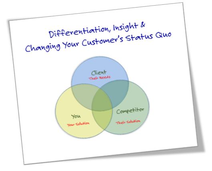Government Sales Falling Short?
Doing all the right things but without results?
Do the sentiments in this email haunt you too?

Companies seeking to generate GSA sales, or government sales in general, often make the same mistake…they do what they are told!
Most federal contractors follow the same federal business development advice and abide by the training they received from GSA, SBA, PTACs, SBDCs, and others. They read the same articles and implement the same programs:
- Federalize their brand
- Register at Sam.gov, FedBizOpps, and related sites
- Prepare a capabilities statement
- Prepare a capabilities deck for presentation to agency personnel
- Conduct government market research
- Identify target agencies based on past purchases, current contracts, and agency forecasts.
- Track GSA eBuy opportunities
- Attend networking events
- Hire a business development representative
- Contact contracting officers, small business liaisons, and partners
- Establish capture management and proposal management processes
- Subscribe to a government RFP database
- Chase federal RFP's
What's Wrong with This?
It's not that these activities are necessarily wrong or useless. They are usually good to do. But here's the problem... to most agency prospects:
You look like all the other contractors
chasing the same RFPs!
So, while I do not advocate abandoning the above practices, I strongly suggest that you need a strategy that goes beyond “me too” federal marketing to sell to the federal government.
Seth Godin had a quote in his blog that is revealing, and I believe too many contractors fall prey to it. Most of their messaging really says:
"You can buy this from anyone, and we're anyone"
That’s what many of your agency contacts feel when they receive yet another basic capabilities statement and the same old capabilities presentation. To agency buyers, end users, and program managers, it often comes across as the same old song with different lyrics. So what’s a firm to do?
Learn to stand out. Isolate what TRULY separates you from the competition. I mean actual, meaningful differences!
Do you articulate value? Do you get to clients early in the buying process? Do you offer a unique approach? Do you use insightful messaging? Without this, all the basic “best” practices fall flat on their face.
You need to learn to identify your differentiators that are truly different from other competitors.
- Being in business since 1992 is not a differentiator – thousands of firms were created in 1992.
- Being the leading provider of (fill in your product or service) is not a differentiator – I bet most of your competitors are the leading providers too.
- Offering the Government efficient and compliant responses to proposals may cut out a few of your competitors, but not many.
- Having the highest ethical standards is great, but is it objective and provable? And aren’t most of your competitors ethical too? At least to the point of not being disbarred.
- And how unique is it to say “We care about our clients,” “We do quality work,” or “We have great people.”
Failure to Differentiate Leads to No Sales
Not long ago, Forrester did a survey of executives and discovered that 85% of the firms selling to them failed to differentiate. The problem with this is obvious – your chances of winning their business are close to nil.
More importantly, these executives often put off making a decision to buy from anyone. Why? Because not only was the decision to choose a firm made more difficult because the buyer saw no difference between them, but the competitors also failed to articulate the value in most cases. This made putting off a decision to buy the best course of action for their organization. True, those organizations may have lost out on whatever value your solution may have provided, but it was your fault that the buyer did not understand your value.
Learn How to Differentiate
Sure, this topic gets a lot of lip service these days, and it always has. But it’s often because firms don’t know how to isolate their differentiators…their unique value proposition.
 Often, executives bring staff together to discuss their attributes and mission statement, develop a tagline, or create an elevator pitch.
Often, executives bring staff together to discuss their attributes and mission statement, develop a tagline, or create an elevator pitch.
None of these are differentiators nor a unique value proposition.
To be a true differentiator, the feature or characteristic must be unique to you AND valuable to your client.
These are the two key attributes of a differentiator. But there is a third component – it must be substantiated. You must prove it to your customers.
These three factors result in the identification of true differentiators. Doing so enables you to create your unique value proposition and effective messaging that will make your capabilities statements, presentations, and marketing campaigns far more effective.
Want to learn more…
Differentiation and Creating Insight to Change Your Client’s Status Quo



